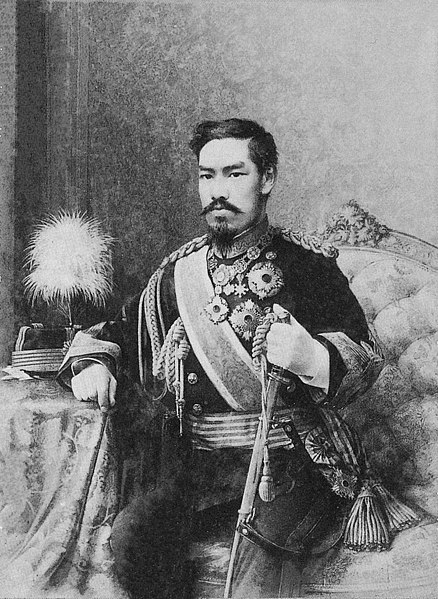Japanese involvement in 19th century Philippines
 |
Toyotomi Hideyoshi reimagined
Photo courtesy of Koei
|
He assembled a fighting force of 300,000 and a navy large enough to support them to invade Korea in 1592. That is almost 2% of the entire Japanese population at the time Korea, which was then known as the Hermit Kingdom, was Hideyoshi's gateway to Ming China, and if ever, the beginning of Japan as a world power. However, after six years of strenuous fighting, Hideyoshi met his death even before his dream came true.
Excluding Korea and China, Hideyoshi also eyed for the Philippines, which was newly unified from an archipelago of separate city-states and independent townships by the Spanish. This was the first time Japan considered the annexation of the Philippines as part of her building an empire in the Pacific. It was 1592 when Hideyoshi demanded the surrender of the Philippines, thinking that the Governor General would cede easily. The Spanish government in Manila was worried of the threat Hideyoshi posed to the Philippines, for they know they cannot put up a fight against the Japanese. The attack of Limahong, a Chinese pirate, in 1574 proved how weak the position of the Spanish was. So, the government decided to send a peace envoy, hoping it would make Hideyoshi change his mind. Apparently, this ruse worked.
 |
| Emperor Meiji (Photo courtesy of Wikipedia) |
The Western view of a "weak" Japan was proven wrong when she made a victory against China in the First Sino-Japanese War, 1894-95. This began the Western powers having a thought of Japan having a Pan Asianism mindset. That is, Japan posing like the savior of Asia from the Western colonizers. Even Spain, which was reeling from the beginning of the Cuban Revolution in 1895, was worried of Japan taking advantage of Spain's weak position and talks of Filipinos beginning a revolution so as to annex the Philippines.
Japanese intentions of annexing the Philippines began to show when plans of the Japanese Army leaked to the West after the First Sino-Japanese War revealed that Japan was thinking of expanding from China to Java in Indonesia. The Philippines was in the middle of Java and China, so it is apparent that Japan was eyeing the archipelago. Also, in 1894, during the coronation of the new Russian czar in Moscow, Yamagata offered to buy the Philippines from Spain for 40 million pounds (in 1890 rates, around 199.20 million U.S. dollars). It was a far cry from the 20 million U.S. dollars America used to buy the Philippines in 1898.
Even the Katipunan considered Japanese aid in their plans about the revolution, especially because Japan did help a revolution succeed in Korea during the First Sino-Japanese War. In May 1896, some of the Katipunan members went to Japan to request the Emperor of considering the Philippines as a protectorate. At around the same time, Emilio Jacinto, the Katipunan secretary, had talks with a certain Japanese admiral named Kanimura concerning Japanese aid to the revolution. The efforts of the Katipunan for Japanese aid were in vain, and it would later be used by the Magdalo faction to nail down the death of Andres Bonifacio, the Katipunan president.
After 1896, Japanese intentions of annexing the Philippines became less clear. One reason could have been was that Japan was afraid it could not take on the other powers who also had intentions of having the Philippines. Another could have been was that she decided to focus more on China, which she already had a sphere of influence like the other Western powers. Whatever the reason, it is evident, in time, that Japan never really gave up on having the Philippines.
World War Two saw a much more powerful Japan which dominated the Asia-Pacific region, including the Philippines. What this article wanted to relay was that Japan began dreaming of annexing the Philippines hundreds of years before the Greater East Asia Co-Prosperity Sphere, and who knows if they will have a try again?
See the references here.






Hi. If I may ask, do u make these posts urself or do u simply copy them from another article? thnx :)
ReplyDeleteI make them myself, and the images are copyleft.
ReplyDeleteThere were factions within the Meiji government regarding Japan's outward policy - to expand Northwards or to expand Southwards. The Choushu faction insisted on a Northward expansion towards Manchuria and Northern China, using the Russian threat as a pretext, while Satsuma wanted to reestablish its historical trade ties with Southern China and Southeast Asia. The Satsuma faction weakened after the Satsuma Rebellion in 1877, with Saigo gone and Okubo assassinated later. The one controlling the army was the Choushu faction under Yamagata, while another Choushu man, Ito Hirobumi, controlled the parliament and favours the establishment of a protectorate for Chosen (Korea) and Manchuria. The Satsuma faction maintained control of the navy but not much else. It was most likely the Satsuma faction that favours the gaining of the Philippines as a foothold in reestablishing economic ties with the South, but were most likely outvoted by the Choushu faction who saw Russia as an immediate threat and insisted that Japan devote all its energies and resources in a war with Russia.
ReplyDelete